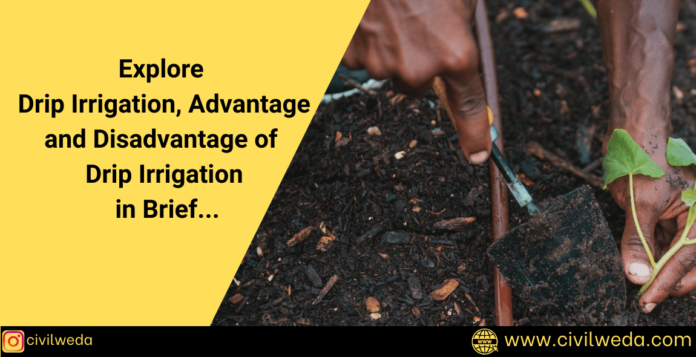Introduction
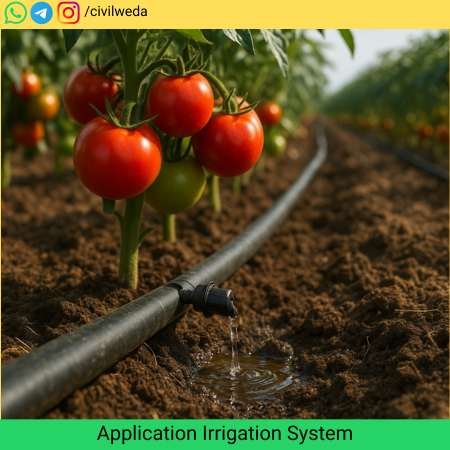
Farming needs a lot of water, but in many areas water is limited. That’s why farmers look for smart ways to save water and still grow good crops. One such method is drip irrigation. In this system, water slowly drips through pipes and small outlets (emitters) directly near the roots of the plants. This way, plants get just the right amount of water, and very little is wasted. Drip irrigation not only saves water but also helps crops grow better, making it one of the most useful irrigation methods for modern farming.
In this article, we will discuss:
- What drip irrigation is and how it works
- The main components of a drip irrigation system
- Advantages and disadvantages of drip irrigation
- Cost and maintenance requirements
- Crops suitable for drip irrigation
- Frequently asked questions related to drip irrigation
By the end, you will have a clear idea of why drip irrigation is considered one of the best modern methods of irrigation.
What is Drip Irrigation?
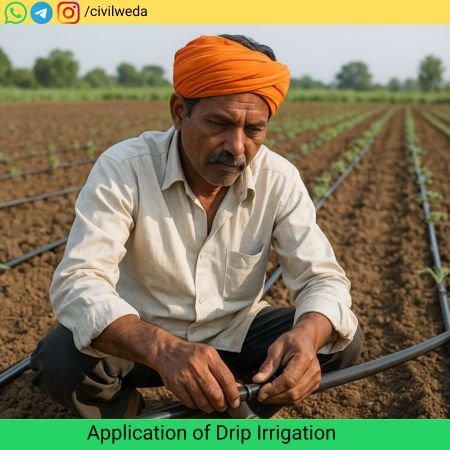
Drip irrigation is a modern and efficient method of irrigation used in farming. In this system, water is supplied drop by drop near the roots of the plants through a network of pipes, tubes, and small outlets called emitters. Because water goes directly to the root zone, plants get the right amount of moisture without wastage. This is why it is also known as the drip irrigation system.
Compared to traditional irrigation methods like flooding or sprinkling, drip irrigation is much more effective. It reduces water loss from evaporation, saves fertilizer, and prevents problems like waterlogging or weed growth. Farmers in many parts of India now prefer this method because it improves crop yield and helps in saving water at the same time. Well-known solutions such as the Jain Irrigation System have made drip irrigation even more popular and accessible.
Overall, drip irrigation is considered one of the best choices for modern agriculture as it combines water conservation with better crop production.
Components of Drip Irrigation System
A drip irrigation system works only when all its parts function properly. Each component has its own role in supplying water directly to the plants. The main parts are:
- Mainline and Sub-main Pipes
These pipes carry water from the source (such as a well, pump, or tank) to the entire field. They act like the backbone of the system and make sure water reaches every section of the farm. - Filters
Clean water is very important for drip irrigation. Filters remove sand, silt, and other particles so that the small outlets (emitters) do not get blocked. Without filters, the system may stop working properly. - Laterals (Small Pipes)
These are narrow pipes connected to the mainline. They spread water across the field row by row. Each lateral line serves a group of plants. - Emitters (Drippers)
Emitters are the heart of the drip irrigation system. They release water slowly and drop by drop near the roots of each plant. This ensures that every plant gets the right amount of water. - Pressure Regulators and Valves
If the water pressure is too high, pipes or emitters can get damaged. Pressure regulators control the flow and keep it uniform across the field. Valves help in opening or closing water supply for different sections. - Pumps and Fertilizer Tank (Optional)
Pumps are used to lift and push water into the system. In many farms, fertilizer tanks are also attached so that nutrients can be given along with water (a process called fertigation). This saves time and improves crop growth.
How Drip Irrigation Works
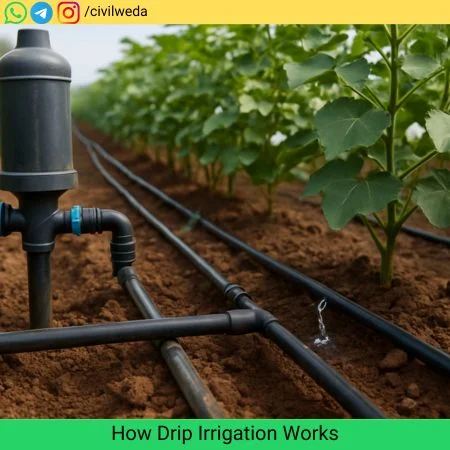
Drip irrigation works on a very simple idea — giving water directly to the roots of the plants, drop by drop. Instead of flooding the whole field, this system focuses only on the plant area.
Here’s how it works step by step:
- Water Source
Water is taken from a well, tank, canal, or any other source. A pump may be used to push water into the system. - Filtration
Before entering the pipes, water passes through filters. This is important to remove sand, silt, or dirt so that the system does not get blocked. - Mainline and Sub-main Pipes
Clean water travels through the main pipes and then moves into smaller sub-main pipes to cover the entire field. - Laterals and Emitters
From the sub-main, water flows into narrow lateral pipes. Small outlets called emitters are fixed on these pipes. Each emitter releases water slowly, directly near the plant roots. - Controlled Supply
Valves and pressure regulators control the amount of water. This makes sure that every plant, whether near or far, gets the same amount of water. - Fertigation
In some systems, a fertilizer tank is connected. This allows farmers to supply nutrients along with water, saving time and improving crop growth.
Fertigation in Drip Irrigation
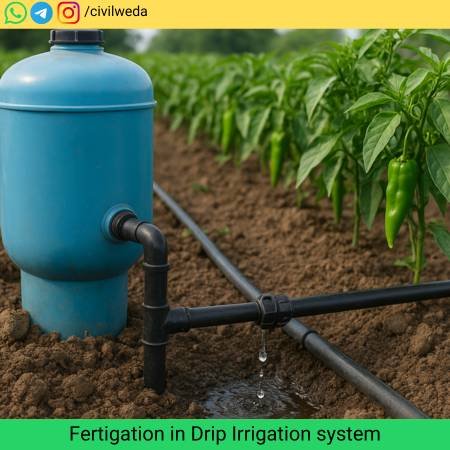
One special feature of drip irrigation is that it can also be used for fertigation. Fertigation means supplying fertilizers along with irrigation water. In this system, a fertilizer tank is connected to the mainline. When water flows through the pipes, the fertilizer also mixes with it and reaches the roots of the plants.
This method has many benefits:
- Fertilizers go directly to the root zone, so plants absorb them quickly.
- It reduces wastage of nutrients and saves cost.
- Farmers save time and labor as irrigation and fertilization happen together.
- It helps in improving crop yield and overall soil health.
Because of these advantages, fertigation is becoming popular among farmers who use drip irrigation systems.
By using this step-by-step process, drip irrigation ensures that crops get enough moisture without wasting water. This is why it is called one of the most efficient irrigation methods in modern farming.
Advantages of Drip Irrigation
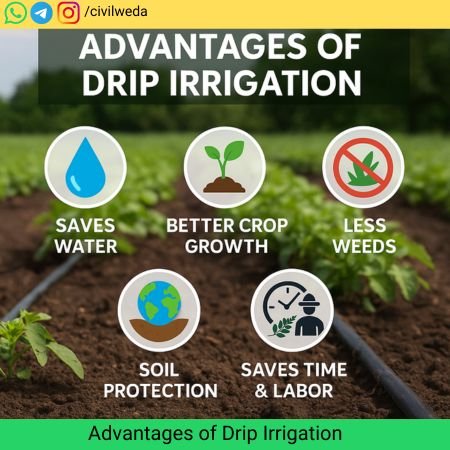
Drip irrigation has become one of the most preferred irrigation methods because it saves resources and increases farm productivity. The main advantages are:
- Efficient Water Use
Water is supplied directly to the plant roots through emitters. This avoids wastage from evaporation, seepage, or surface runoff. Farmers can save up to 30–60% water compared to traditional methods. - Improved Crop Yield
Plants receive a steady and uniform supply of water, which keeps the soil moisture balanced. This results in healthier plants, faster growth, and better quality produce. - Nutrient Management with Fertigation
By using a fertilizer tank, nutrients can be given along with irrigation water. This process, called fertigation, reduces fertilizer loss and ensures that plants get the right nutrition at the right time. - Reduced Weed Growth
Since only the root zone of the plant is watered, the spaces between rows remain dry. This limits weed germination and reduces the cost of weed control. - No Soil Erosion or Waterlogging
The controlled water supply prevents flooding of fields. It protects the soil structure, avoids erosion, and eliminates problems like waterlogging. - Suitable for a Wide Range of Crops
Drip irrigation is used successfully in vegetables, fruit orchards, sugarcane, cotton, flowers, and even small gardens or greenhouse farming. - Time and Labor Saving
Once installed, the system works automatically. Farmers do not need to manually water the crops, which saves time, reduces labor costs, and makes farming more efficient.
Cost of Drip Irrigation in India
The cost of drip irrigation system in India is not fixed. It depends on the size of the farm, type of crop, quality of materials, and the overall design of the system. On average, the cost of drip irrigation per acre in India is around ₹45,000 to ₹65,000. For very small gardens or kitchen farms, the cost may be much lower, while for large orchards or high-value crops, the cost may be slightly higher.
Main Factors Affecting the Cost
- Farm Size and Crop Type
- Bigger farms and crops like sugarcane, cotton, and orchards need more pipes and emitters, which increases the price.
- Quality of Equipment
- Branded products such as Jain Irrigation System cost a bit more, but they are durable and reduce future repair expenses.
- Water Source and Pumps
- If a pump is required to lift water from wells or tanks, the cost of the irrigation system increases.
- Design and Layout
- A well-designed drip system ensures equal water supply but may need professional installation, adding to the cost.
Maintenance Cost
Every year, farmers also need to spend some money on upkeep. Cleaning filters, replacing emitters, and fixing small leaks usually cost about ₹2,000 to ₹5,000 per acre per year.
Subsidy and Government Support
Subsidy and Government Support
To make modern irrigation affordable, the Government of India provides financial support under the Pradhan Mantri Krishi Sinchayee Yojana (PMKSY – Per Drop More Crop) scheme:
- Small and marginal farmers usually get about 55% subsidy on the system cost.
- Other farmers may receive around 45% subsidy.
- Some state governments also add extra support, so the final subsidy amount may vary.
👉 Farmers should always check with their state agriculture department or local offices to know the exact subsidy available in their area.
Popular Drip Irrigation Brands in India
Along with traditional systems, many companies now provide modern drip irrigation systems that help farmers save water and increase crop yield. These brands design and manufacture equipment such as pipes, emitters, filters, pumps, and complete irrigation kits.
Some of the leading brands in India are:
- Jain Irrigation Systems Ltd. – A pioneer in drip irrigation, offering a wide range of pipes, drip lines, and fertigation solutions.
- Netafim India – An international company known for advanced micro-irrigation technologies suitable for both small farms and large plantations.
- Finolex Plasson Industries – Provides high-quality pipes, fittings, and irrigation accessories with good durability.
By using products from trusted brands, farmers benefit from:
- Longer life of the system due to better material quality
- Reduced chances of clogging or leakage
- Availability of after-sales service and technical support
👉 These companies have made drip irrigation in India more reliable and affordable, encouraging more farmers to adopt this modern irrigation method.
Applications and Crops Suitable for Drip Irrigation
Drip irrigation is widely used in farming because it works well in many situations. It is especially useful in areas where water is limited and farmers need to save every drop. This modern irrigation method is suitable for different types of crops and farms.
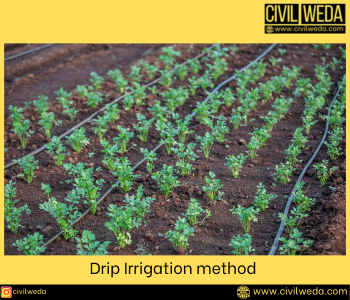
Crops Suitable for Drip Irrigation
- Vegetables
- Tomato, brinjal, chili, cauliflower, cabbage, onion, and other vegetables grow very well under drip irrigation.
- Fruits and Orchards
- Mango, banana, grapes, papaya, citrus fruits, pomegranate, and guava are commonly irrigated with this system.
- Orchards benefit the most because water is delivered directly to the root zone of each tree.
- Commercial Crops
- Sugarcane, cotton, tobacco, tea, and coffee plantations use drip irrigation to save water and increase yield.
- Flowers and Spices
- Crops like roses, marigold, jasmine, cardamom, and black pepper also show better growth with this modern irrigation system.
- Greenhouses and Kitchen Gardens
- Irrigation is perfect for controlled environments like greenhouses.
- It is also widely used in small kitchen gardens and lawn irrigation.
Other Applications
- Water-scarce regions: Farmers in arid and semi-arid regions use drip irrigation to grow crops successfully.
- Saline soils: Drip irrigation reduces salt build-up on the soil surface by keeping the top layer relatively dry.
- Fertigation: It can be used for supplying fertilizers along with water, improving nutrient use efficiency
Frequently Asked Questions on Drip Irrigation
1. What is the cost of drip irrigation per acre in India?
The average cost of drip irrigation per acre in India is around ₹45,000 to ₹65,000. The price depends on farm size, crop type, quality of pipes and emitters, and system design.
2. Which crops are best suited for drip irrigation?
Drip irrigation works best for vegetables (tomato, onion, chili), fruits (mango, banana, grapes, pomegranate), commercial crops (sugarcane, cotton), and also for flowers, spices, and greenhouse farming.
3. What are the main advantages of drip irrigation?
It saves 30–60% water, improves crop yield, reduces weed growth, prevents soil erosion, and allows fertigation (supplying fertilizers along with irrigation water).
4. Are there any disadvantages of drip irrigation?
Yes. The system has a higher initial cost, requires regular maintenance, and emitters can get clogged if water is not properly filtered.
5. What is the subsidy available for drip irrigation in India?
Under the PMKSY – Per Drop More Crop scheme, small and marginal farmers usually get about 55% subsidy, while other farmers get around 45% subsidy. Some states also provide extra support, so the total benefit may vary.
6. How much is the maintenance cost of drip irrigation?
The maintenance cost of drip irrigation system is usually ₹2,000 to ₹5,000 per acre per year. This includes cleaning filters, repairing leaks, and replacing emitters.
7. Can drip irrigation be used in small gardens or kitchen farming?
Yes, drip irrigation is very effective in kitchen gardens, home lawns, and greenhouses. Small kits are available at affordable prices for household use.
Conclusion
This irrigation method is one of the most effective and modern irrigation methods that saves water and increases crop yield. By delivering water directly to the plant roots, it reduces wastage, improves soil health, and makes farming more efficient. Though the system requires an initial investment and regular maintenance, the long-term benefits are much higher.
With government subsidies and the availability of branded drip irrigation systems in India, more and more farmers are adopting this method. Whether it is vegetables, fruits, commercial crops, or even small gardens, drip irrigation proves to be a smart and sustainable choice for the future of farming.
If you found this article useful, share it with other students and farmers who want to learn about modern irrigation methods.

